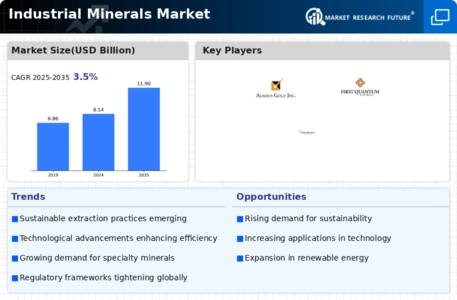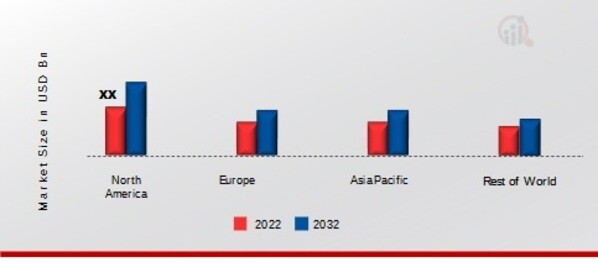-
EXECUTIVE SUMMARY
-
MARKET INTRODUCTION
-
Definition
-
Scope of the Study
- Research Objective
- Assumptions
- Limitations
-
RESEARCH METHODOLOGY
-
Overview
-
Data Mining
-
Secondary Research
-
Primary Research
- Primary Interviews and Information Gathering Process
- Breakdown of Primary Respondents
-
Forecasting Model
-
Market Size Estimation
- Bottom-Up Approach
- Top-Down Approach
-
Data Triangulation
-
Validation
-
MARKET DYNAMICS
-
Overview
-
Drivers
-
Restraints
-
Opportunities
-
MARKET FACTOR ANALYSIS
-
Value Chain Analysis
-
Porter’s Five Forces Analysis
- Bargaining Power of Suppliers
- Bargaining Power of Buyers
- Threat of New Entrants
- Threat of Substitutes
- Intensity of Rivalry
-
COVID-19 Impact Analysis
- Market Impact Analysis
- Regional Impact
- Opportunity and Threat Analysis
-
GLOBAL INDUSTRIAL MINERALS MARKET, BY TYPE
-
Overview
-
Red Ocher
-
Limestone
-
Silicon Dioxide (SiO2)
-
Dolomite (CaMg(CO3)2)
-
Others
-
GLOBAL INDUSTRIAL MINERALS MARKET, BY APPLICATION
-
Overview
-
Building Materials
-
Paint
-
Ceramics
-
Glass
-
Plastics
-
Paper
-
Electronics
-
Detergents
-
Medications and Medical Devices
-
Others
-
GLOBAL INDUSTRIAL MINERALS MARKET, BY REGION
-
Overview
-
North America
- US
- Canada
-
Europe
- Germany
- France
- UK
- Italy
- Spain
- Rest of Europe
-
Asia-Pacific
- China
- India
- Japan
- South Korea
- Australia
- Rest of Asia-Pacific
-
Rest of the World
- Middle East
- Africa
- Latin America
-
COMPETITIVE LANDSCAPE
-
Overview
-
Competitive Analysis
-
Market Share Analysis
-
Major Growth Strategy in the Global Industrial Minerals Market,
-
Competitive Benchmarking
-
Leading Players in Terms of Number of Developments in the Global Industrial Minerals Market,
-
Key developments and Growth Strategies
- New Product Launch/Service Deployment
- Merger & Acquisitions
- Joint Ventures
-
Major Players Financial Matrix
- Sales & Operating Income, 2022
- Major Players R&D Expenditure. 2022
-
COMPANY PROFILES
-
Gentor Resources Inc
- Company Overview
- Financial Overview
- Products Offered
- Key Developments
- SWOT Analysis
- Key Strategies
-
Alamos Gold Inc
- Company Overview
- Financial Overview
- Products Offered
- Key Developments
- SWOT Analysis
- Key Strategies
-
KOZA ALTIN ISLETMELERI
- Company Overview
- Financial Overview
- Products Offered
- Key Developments
- SWOT Analysis
- Key Strategies
-
Anatolia Energy Ltd
- Company Overview
- Financial Overview
- Products Offered
- Key Developments
- SWOT Analysis
- Key Strategies
-
Stratex International. P.l.c
- Company Overview
- Financial Overview
- Products Offered
- Key Developments
- SWOT Analysis
- Key Strategies
-
Alara Resources Ltd
- Company Overview
- Financial Overview
- Products Offered
- Key Developments
- SWOT Analysis
- Key Strategies
-
First Quantum Minerals Ltd
- Company Overview
- Financial Overview
- Products Offered
- Key Developments
- SWOT Analysis
- Key Strategies
-
Invictus Gold Ltd
- Company Overview
- Financial Overview
- Products Offered
- Key Developments
- SWOT Analysis
- Key Strategies
-
COLUMBUS COPPER CORP
- Company Overview
- Financial Overview
- Products Offered
- Key Developments
- SWOT Analysis
- Key Strategies
-
Centerra Gold Inc
- Company Overview
- Financial Overview
- Products Offered
- Key Developments
- SWOT Analysis
- Key Strategies
-
Eldorado Gold Corp
- Company Overview
- Financial Overview
- Products Offered
- Key Developments
- SWOT Analysis
- Key Strategies
-
Diamond Fields International Ltd
- Company Overview
- Financial Overview
- Products Offered
- Key Developments
- SWOT Analysis
- Key Strategies
-
Ruukki Group
- Company Overview
- Financial Overview
- Products Offered
- Key Developments
- SWOT Analysis
- Key Strategies
-
Eurasian Minerals Inc
- Company Overview
- Financial Overview
- Products Offered
- Key Developments
- SWOT Analysis
- Key Strategies
-
National Iranian Copper Corp
- Company Overview
- Financial Overview
- Products Offered
- Key Developments
- SWOT Analysis
- Key Strategies
-
APPENDIX
-
References
-
Related Reports
-
-
LIST OF TABLES
-
GLOBAL INDUSTRIAL MINERALS MARKET, SYNOPSIS, 2018-2032
-
GLOBAL INDUSTRIAL MINERALS MARKET, ESTIMATES & FORECAST, 2018-2032 (USD BILLION)
-
GLOBAL INDUSTRIAL MINERALS MARKET, BY TYPE, 2018-2032 (USD BILLION)
-
GLOBAL INDUSTRIAL MINERALS MARKET, BY APPLICATION, 2018-2032 (USD BILLION)
-
NORTH AMERICA: INDUSTRIAL MINERALS MARKET, BY TYPE, 2018-2032 (USD BILLION)
-
NORTH AMERICA: INDUSTRIAL MINERALS MARKET, BY APPLICATION, 2018-2032 (USD BILLION)
-
US: INDUSTRIAL MINERALS MARKET, BY TYPE, 2018-2032 (USD BILLION)
-
US: INDUSTRIAL MINERALS MARKET, BY APPLICATION, 2018-2032 (USD BILLION)
-
CANADA: INDUSTRIAL MINERALS MARKET, BY TYPE, 2018-2032 (USD BILLION)
-
CANADA: INDUSTRIAL MINERALS MARKET, BY APPLICATION, 2018-2032 (USD BILLION)
-
EUROPE: INDUSTRIAL MINERALS MARKET, BY TYPE, 2018-2032 (USD BILLION)
-
EUROPE: INDUSTRIAL MINERALS MARKET, BY APPLICATION, 2018-2032 (USD BILLION)
-
GERMANY: INDUSTRIAL MINERALS MARKET, BY TYPE, 2018-2032 (USD BILLION)
-
GERMANY: INDUSTRIAL MINERALS MARKET, BY APPLICATION, 2018-2032 (USD BILLION)
-
FRANCE: INDUSTRIAL MINERALS MARKET, BY TYPE, 2018-2032 (USD BILLION)
-
FRANCE: INDUSTRIAL MINERALS MARKET, BY APPLICATION, 2018-2032 (USD BILLION)
-
ITALY: INDUSTRIAL MINERALS MARKET, BY TYPE, 2018-2032 (USD BILLION)
-
ITALY: INDUSTRIAL MINERALS MARKET, BY APPLICATION, 2018-2032 (USD BILLION)
-
SPAIN: INDUSTRIAL MINERALS MARKET, BY TYPE, 2018-2032 (USD BILLION)
-
SPAIN: INDUSTRIAL MINERALS MARKET, BY APPLICATION, 2018-2032 (USD BILLION)
-
UK: INDUSTRIAL MINERALS MARKET, BY TYPE, 2018-2032 (USD BILLION)
-
UK: INDUSTRIAL MINERALS MARKET, BY APPLICATION, 2018-2032 (USD BILLION)
-
REST OF EUROPE: INDUSTRIAL MINERALS MARKET, BY TYPE, 2018-2032 (USD BILLION)
-
REST OF EUROPE: INDUSTRIAL MINERALS MARKET, BY APPLICATION, 2018-2032 (USD BILLION)
-
ASIA-PACIFIC: INDUSTRIAL MINERALS MARKET, BY TYPE, 2018-2032 (USD BILLION)
-
ASIA-PACIFIC: INDUSTRIAL MINERALS MARKET, BY APPLICATION, 2018-2032 (USD BILLION)
-
JAPAN: INDUSTRIAL MINERALS MARKET, BY TYPE, 2018-2032 (USD BILLION)
-
JAPAN: INDUSTRIAL MINERALS MARKET, BY APPLICATION, 2018-2032 (USD BILLION)
-
CHINA: INDUSTRIAL MINERALS MARKET, BY TYPE, 2018-2032 (USD BILLION)
-
CHINA: INDUSTRIAL MINERALS MARKET, BY APPLICATION, 2018-2032 (USD BILLION)
-
INDIA: INDUSTRIAL MINERALS MARKET, BY TYPE, 2018-2032 (USD BILLION)
-
INDIA: INDUSTRIAL MINERALS MARKET, BY APPLICATION, 2018-2032 (USD BILLION)
-
AUSTRALIA: INDUSTRIAL MINERALS MARKET, BY TYPE, 2018-2032 (USD BILLION)
-
AUSTRALIA: INDUSTRIAL MINERALS MARKET, BY APPLICATION, 2018-2032 (USD BILLION)
-
SOUTH KOREA: INDUSTRIAL MINERALS MARKET, BY TYPE, 2018-2032 (USD BILLION)
-
SOUTH KOREA: INDUSTRIAL MINERALS MARKET, BY APPLICATION, 2018-2032 (USD BILLION)
-
REST OF ASIA-PACIFIC: INDUSTRIAL MINERALS MARKET, BY TYPE, 2018-2032 (USD BILLION)
-
REST OF ASIA-PACIFIC: INDUSTRIAL MINERALS MARKET, BY APPLICATION, 2018-2032 (USD BILLION)
-
REST OF THE WORLD: INDUSTRIAL MINERALS MARKET, BY TYPE, 2018-2032 (USD BILLION)
-
REST OF THE WORLD: INDUSTRIAL MINERALS MARKET, BY APPLICATION, 2018-2032 (USD BILLION)
-
MIDDLE EAST: INDUSTRIAL MINERALS MARKET, BY TYPE, 2018-2032 (USD BILLION)
-
MIDDLE EAST: INDUSTRIAL MINERALS MARKET, BY APPLICATION, 2018-2032 (USD BILLION)
-
AFRICA: INDUSTRIAL MINERALS MARKET, BY TYPE, 2018-2032 (USD BILLION)
-
AFRICA: INDUSTRIAL MINERALS MARKET, BY APPLICATION, 2018-2032 (USD BILLION)
-
LATIN AMERICA: INDUSTRIAL MINERALS MARKET, BY TYPE, 2018-2032 (USD BILLION)
-
LATIN AMERICA: INDUSTRIAL MINERALS MARKET, BY APPLICATION, 2018-2032 (USD BILLION)
-
LIST OF FIGURES
-
RESEARCH PROCESS
-
MARKET STRUCTURE FOR THE GLOBAL INDUSTRIAL MINERALS MARKET
-
MARKET DYNAMICS FOR THE GLOBAL INDUSTRIAL MINERALS MARKET
-
GLOBAL INDUSTRIAL MINERALS MARKET, SHARE (%), BY TYPE, 2022
-
GLOBAL INDUSTRIAL MINERALS MARKET, SHARE (%), BY APPLICATION, 2022
-
GLOBAL INDUSTRIAL MINERALS MARKET, SHARE (%), BY REGION, 2022
-
NORTH AMERICA: INDUSTRIAL MINERALS MARKET, SHARE (%), BY REGION, 2022
-
EUROPE: INDUSTRIAL MINERALS MARKET, SHARE (%), BY REGION, 2022
-
ASIA-PACIFIC: INDUSTRIAL MINERALS MARKET, SHARE (%), BY REGION, 2022
-
REST OF THE WORLD: INDUSTRIAL MINERALS MARKET, SHARE (%), BY REGION, 2022
-
GLOBAL INDUSTRIAL MINERALS MARKET: COMPANY SHARE ANALYSIS, 2022 (%)
-
GENTOR RESOURCES INC: FINANCIAL OVERVIEW SNAPSHOT
-
GENTOR RESOURCES INC: SWOT ANALYSIS
-
ALAMOS GOLD INC: FINANCIAL OVERVIEW SNAPSHOT
-
ALAMOS GOLD INC: SWOT ANALYSIS
-
KOZA ALTIN ISLETMELERI: FINANCIAL OVERVIEW SNAPSHOT
-
KOZA ALTIN ISLETMELERI: SWOT ANALYSIS
-
ANATOLIA ENERGY LTD: FINANCIAL OVERVIEW SNAPSHOT
-
ANATOLIA ENERGY LTD: SWOT ANALYSIS
-
STRATEX INTERNATIONAL. P.L.C: FINANCIAL OVERVIEW SNAPSHOT
-
STRATEX INTERNATIONAL. P.L.C.: SWOT ANALYSIS
-
ALARA RESOURCES LTD: FINANCIAL OVERVIEW SNAPSHOT
-
ALARA RESOURCES LTD: SWOT ANALYSIS
-
FIRST QUANTUM MINERALS LTD: FINANCIAL OVERVIEW SNAPSHOT
-
FIRST QUANTUM MINERALS LTD: SWOT ANALYSIS
-
INVICTUS GOLD LTD: FINANCIAL OVERVIEW SNAPSHOT
-
INVICTUS GOLD LTD: SWOT ANALYSIS
-
COLUMBUS COPPER CORP: FINANCIAL OVERVIEW SNAPSHOT
-
COLUMBUS COPPER CORP: SWOT ANALYSIS
-
CENTERRA GOLD INC: FINANCIAL OVERVIEW SNAPSHOT
-
CENTERRA GOLD INC: SWOT ANALYSIS
-
ELDORADO GOLD CORP: FINANCIAL OVERVIEW SNAPSHOT
-
ELDORADO GOLD CORP: SWOT ANALYSIS
-
DIAMOND FIELDS INTERNATIONAL LTD: FINANCIAL OVERVIEW SNAPSHOT
-
DIAMOND FIELDS INTERNATIONAL LTD: SWOT ANALYSIS
-
RUUKKI GROUP: FINANCIAL OVERVIEW SNAPSHOT
-
RUUKKI GROUP: SWOT ANALYSIS
-
EURASIAN MINERALS INC: FINANCIAL OVERVIEW SNAPSHOT
-
EURASIAN MINERALS INC: SWOT ANALYSIS
-
NATIONAL IRANIAN COPPER CORP: FINANCIAL OVERVIEW SNAPSHOT
-
NATIONAL IRANIAN COPPER CORP: SWOT ANALYSIS


 Source: Secondary Research, Primary Research, Market Research Future Database and Analyst Review
Source: Secondary Research, Primary Research, Market Research Future Database and Analyst Review



Leave a Comment